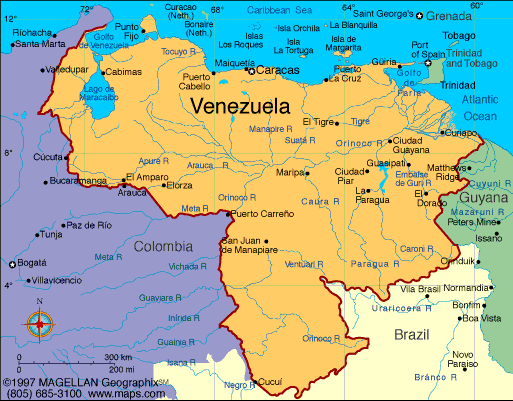Venezuela Map: Regions, Geography, Facts & Figures
Venezuela, officially recognized as the Bolivarian Republic of Venezuela, is a captivating country nestled on the Caribbean coast of South America. Not only does it share borders with Guyana, Brazil, and Colombia, but its coastline also opens up to the vast Atlantic Ocean. Its strategic location places it within close proximity to Trinidad and Tobago, a vibrant nation adorning the Caribbean Sea, and within reach of both North and Latin America.
If you want to discover more in-depth information on Iran as a country, check out our Venezuela Profile!
Plus, test your country knowledge with our South American geography quiz, Can You Name These South American Landmarks?

History of Venezuela
Venezuela's history is steeped in influences from European colonization and indigenous cultures. It was in 1821 that this South American nation gained independence from Spain, a monumental occasion led by Simón Bolívar, a Venezuelan military and political leader. Bolívar’s influence was not confined to Venezuela, as he played a crucial role in the liberation of several other Latin American countries, including Bolivia, lending his name to the country.
Geography of Venezuela
Venezuela's geography is a medley of stunning contrasts. From the towering Andes Mountains, the northern mountain range of South America, to the verdant Maracaibo Lowlands and the mysterious Guiana Highlands, the country boasts an array of geographical wonders. The highest peaks in Venezuela include Pico Bolívar and Pico Humboldt in the Andes.
The country's geography extends to its coastal regions, where the Caribbean Sea graces the northern border with its azure waters. The Orinoco River, one of the longest in South America, winds its way through Venezuela’s diverse landscapes, while Lake Maracaibo, located in western Venezuela, stands as one of the largest natural lakes in South America.
Neighboring Countries and Relationships
Venezuela's place on the world map and political map goes beyond its geographical coordinates. Its rich history, cultural heritage, and political evolution have contributed to shaping the socio-political dynamics of the region. Its influence extends beyond South America and the Caribbean Coast, reaching out to countries in North America, Europe, and beyond.
The country shares not just borders, but also economic and cultural ties with neighboring countries. Its relationships with countries such as Colombia, Brazil, and Guyana extend beyond geographic proximity. For instance, trade relations with Chile and Peru have seen significant growth over the years.
Tourist Attractions in Venezuela
The map of Venezuela, with its mix of history, culture, and nature, offers numerous captivating tourist attractions. Angel Falls, the highest waterfall on Earth, is tucked away in the heart of the country, a pure, unadulterated spectacle of nature's majesty. The diverse landscapes of Canaima National Park are a world unto themselves, attracting globetrotters from around the world.
Venezuela’s Cities
The pulsating heart of Venezuela is its capital city, Caracas, which along with other major cities like Maracaibo, Valencia, Ciudad Guayana, and San Cristóbal, showcases the rich tapestry of Venezuelan culture. Each city is unique, with places like Barquisimeto, known as the musical capital of Venezuela, and Maracay, often referred to as the Garden City, offering contrasting experiences for visitors and locals alike. Mérida offers a rich cultural experience, juxtaposed with the colonial charm of the historic city of Coro. The city of Barinas, located in Venezuela's Llanos region, is another notable city, particularly for its remarkable agro-tourism.

People Also Ask…
If you're inspecting a map of South America, you may have some queries about the region of Venezuela. Here are some of the most frequently asked questions, along with their answers.
What Is the Official Language of Venezuela?
While Spanish is the official language of Venezuela, English is widely taught in schools and universities. Indeed, in major cities like Caracas, Maracay, and even Barcelona, an important city in the eastern part of the country, one can find a growing number of English language centers.
What Is Venezuela Most Known For?
Venezuela is known for its vibrant culture, diverse geography, unique wildlife, and rich natural resources. The country has a long history of producing oil and has been an important source of oil for the world. Additionally, Venezuela is home to some of the most remarkable biodiversity in South America with over 500 species of birds that live within its borders.
Why Is Venezuela in Crisis?
Venezuela is in a state of economic and political crisis due to the mismanagement of its government, particularly in terms of its fiscal and monetary policies. In addition, the country has suffered from food shortages, inflation, currency devaluation, and rising crime rates. The Venezuelan government has implemented new economic reforms which have had limited success.
|
|








